A resettable fuse, or PTC device, is a self-resetting overcurrent protector in electronic circuits, offering reliability, efficiency, and compact size.

Resettable Fuse (PTC): An Introduction to Polymer Positive Temperature Coefficient Devices
A resettable fuse, also known as a Polymer Positive Temperature Coefficient (PTC) device, is a crucial component in electronic circuits that provides overcurrent protection. These fuses automatically reset after a fault, making them a more economical and efficient choice compared to traditional fuses, which require replacement after each fault event. In this article, we will delve into the workings of PTC devices, their benefits, and their applications in various industries.
Understanding PTC Devices
PTC devices are composed of a semiconductive polymer, which is a material that exhibits a positive temperature coefficient. This means that as the temperature of the polymer increases, its electrical resistance increases as well. When a PTC device is operating under normal conditions, it remains in a low-resistance state, allowing the current to flow through the circuit with minimal resistance. However, when the current exceeds a specified limit, the device heats up rapidly, and its resistance increases significantly. This change in resistance helps to limit the current flow, protecting the circuit from potential damage due to overcurrent conditions.
How Resettable Fuses Work
Resettable fuses are designed to ‘trip’ when the current flowing through the device exceeds its rated value. The trip occurs as a result of the self-heating effect caused by the increased current. As the temperature of the PTC device rises, its resistance increases, effectively limiting the current flow through the circuit. Once the overcurrent condition is removed and the device cools down, its resistance returns to its original low-resistance state, allowing the fuse to automatically reset and resume normal operation. This self-resetting capability eliminates the need to replace the fuse manually and reduces downtime in the event of a fault.
Advantages of Resettable Fuses
There are several benefits to using resettable fuses in electronic circuits, including:
- Automatic Reset: Unlike traditional fuses that must be replaced after a fault event, PTC devices automatically reset, reducing maintenance and downtime.
- Long Service Life: PTC devices can withstand numerous overcurrent events without any degradation in performance, making them highly reliable and long-lasting.
- Compact Size: Due to their small size, PTC devices can be easily integrated into electronic circuits, making them an ideal choice for various applications.
- Fast Response Time: PTC devices respond quickly to overcurrent conditions, offering improved protection compared to traditional fuses.
- Environmentally Friendly: Since they do not require replacement, PTC devices generate less waste, contributing to a greener environment.
Applications of Resettable Fuses
Resettable fuses are widely used across various industries due to their versatility and reliability. Some common applications include:
- Consumer electronics, such as smartphones, laptops, and gaming consoles
- Power supplies and adapters
- Telecommunication equipment
- Automotive electronics
- Industrial control systems
Types of Resettable Fuses
There are two main types of resettable fuses: radial leaded and surface mount. Each type has its unique characteristics and applications:
- Radial Leaded: These PTC devices are designed for through-hole mounting on printed circuit boards (PCBs). They are commonly used in power supplies, chargers, and various consumer electronics.
- Surface Mount: Surface mount resettable fuses are designed for automatic assembly on PCBs using surface mount technology (SMT). They are typically smaller in size and can handle higher current ratings. Surface mount PTC devices are often found in high-density electronic applications, such as smartphones and tablets.
Selection Criteria for Resettable Fuses
When choosing a resettable fuse, it is essential to consider the following factors:
- Hold Current: This is the maximum current a PTC device can handle without tripping. The hold current should be selected based on the normal operating current of the application.
- Trip Current: The trip current is the minimum current at which the PTC device will start to increase its resistance rapidly. It should be chosen based on the maximum allowable current for the circuit being protected.
- Maximum Voltage: The PTC device’s maximum voltage rating should be higher than the highest voltage present in the application to ensure safe operation.
- Time-to-Trip: This is the time it takes for the PTC device to trip in response to an overcurrent event. A faster time-to-trip ensures better protection for the circuit.
- Size and Form Factor: The physical size and form factor of the resettable fuse should be compatible with the space available on the PCB and the overall design of the electronic device.
Conclusion
Resettable fuses, or PTC devices, offer a reliable and efficient solution for overcurrent protection in electronic circuits. With their automatic reset capability, long service life, and compact size, they have become the preferred choice for many industries, including consumer electronics, automotive, and telecommunications. By understanding the types, applications, and selection criteria for resettable fuses, engineers and designers can make informed decisions when incorporating these critical components into their designs, ensuring the safety and reliability of their products.

